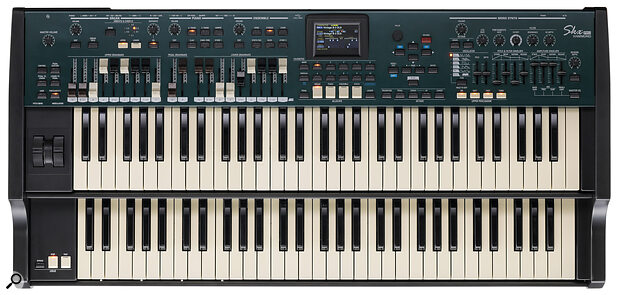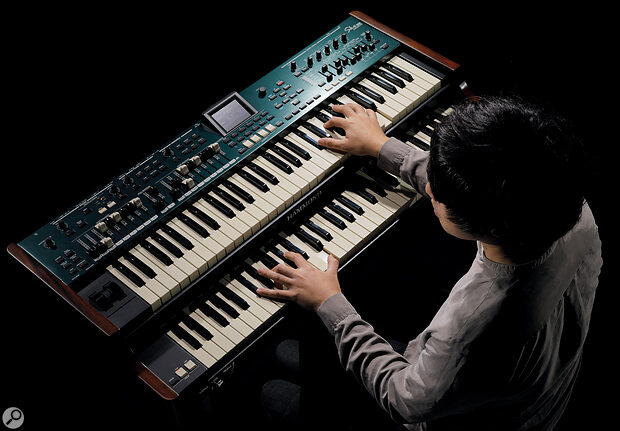The Hammond SKX Pro may not be cheap, but boy do you get a lot for your money.
Thirty years ago, Hammond were at the forefront of the rush to create digital emulations of their own tonewheel organs played through Leslie speakers. In 1992, I thought that the sound of the Hammond XB‑2 was great, but progress was rapid, and the pursuit of digital tonewheel perfection led me to Roland VKs, Korg CXs and BXs, Oberheim OBs, Hammond XKs and various Nords, and each (with the occasional exception) was better than the previous. So, as the newest entrant to the field, is the SKX Pro the best yet?
At roughly a metre wide and weighing 18Kg, it’s slightly larger and heavier than its predecessor, the SKX, but its revised control panel is now centred around a 320 x 240‑pixel colour display, which is a big step forward. True, it’s still small by modern standards but, with lots of controls as well as two full sets of drawbars plus pedal drawbars on the top panel, there’s no space for anything larger. Its manuals are 61‑note, semi‑weighted and velocity sensitive, but aftertouch is not supported. In my view, Hammond made a mistake here. An instrument like this deserves to be played using both hands, so what do you do when you want to perform tasks that would otherwise require that you lift your hands from the manuals? You can assign pedals, but the obvious solution is to press a bit harder on the keyboard.
It has three underlying sound generators that drive four sections: an organ with vintage Hammond, Vox, Farfisa, AceTone and pipe organ emulations; a sample‑based polysynth that provides the voices for its piano and ensemble sections; and a virtual analogue monosynth. But since the Hammond emulation will be the raison d’être of the SKX Pro for the majority of people, let’s start there...
Organs
The organ section is based upon the MTW1 system that powers the top‑of‑the‑range Hammond XK5. It is 61‑note polyphonic and offers X5/B3000 voicing as well as the expected B3, C3 and A100. Its tonewheel model is called a Virtual Tonewheel Set and, in addition to providing access to the underlying organ type and revision, it can be edited on a wheel‑by‑wheel basis, allowing you to determine the tone and leakage from each, as well as how the drawbar position affects the level of each. You can also choose which of Hammond’s pedal generation methods is used as well as the registrations and actions of the pedal drawbars. It’s fiendishly detailed, and if you have a favourite but idiosyncratic vintage organ, you can recreate it here.
The output from the Set is directed to a virtual Matching Transformer that mixes the pitches as you play them, and the output from this feeds an emulation of the scanner chorus/vibrato before being passed to the MFX1 (multi‑effects) section, an overdrive, and the MFX2 section. The signal then reaches a tone control and EQ before being fed to the Leslie speaker emulation (if used) and a reverb. If wanted, the sounds generated by the bass pedal section can bypass the chorus/vibrato and feed straight into the effects chain, or skip this too and feed into the tone control and EQ before being passed to the Leslie effect or to a dedicated ‘clean’ output.
Once you’ve chosen a preset Tonewheel Set or defined your own you can program the key click and percussion, and determine how much compression is applied as you add notes to a chord. You can also select how the virtual bus bars respond when you press a key, using the Virtual Multi Contact technology to emulate how different footages could sound at slightly different moments when playing a B3, C3 or A100. There’s even a set of Tonewheel Brake parameters. Back when I were but a lad, players would switch off valve‑based Hammonds to create downward pitch bends and on again to swoop back up to the played pitch. Depending upon the model, this could also create a dip in amplitude, and all of this can be recreated on the SKX Pro.
You can also modify the Leslie effect, choosing from various cabinets, programming the horn and rotor speeds and accelerations, determining the virtual microphone setup, and adding a dry (non‑rotating) sub‑bass should you want it. In addition, you can place the rotary effect after the reverb, which is something that I’ve been requesting from elsewhere for years. Of course, none of this description tells you how good the Hammond+Leslie emulation sounds... but it sounds VERY good.
The next organ family is that of pipe organs. I wasn’t impressed with this at first, but then I discovered how to customise the pipes, choosing from 46 ranks for each of the drawbars, adjusting their pitches and tuning, their levels, brightnesses, the position of each rank in the soundfield, how the pipes are arranged, the amount of chiff, and whether a tremulant is applied. These allowed me to create organs ranging from the smallest and flutiest chapel organs through to large instruments with strident diapasons, blaring brass and raucous mixtures. You won’t replace a full Hauptwerk setup with an SKX Pro but, if your needs are more modest, you could be very happy with this.
The SKX Pro also provides models of Vox, Farfisa and AceTone organs. The Vox emulation recreates the sine and triangle wave contributions of the Vox Continental as well as the footages and mixtures of various models. Similarly, the AceTone emulates the TOP‑7 while the Farfisa model recreates the single‑manual Compact although, in both these cases, their on/off tabs have been replaced by drawbars that progressively introduce the voices. They all have the character of their originals and, if you invoke the overdrive and EQ, you can approach the anti‑social natures of both the Vox and the Farfisa. However, Hammond missed another trick with the Farfisa model because later Compacts dropped the 4’ Piccolo, added 2+2/3’ and Brilliant tabs, and added the Multi Tone Booster tabs that generated their most aggressive and recognisable sounds. Consequently, I would still use an original Compact Duo if the music demanded it.
Piano & Ensemble
The piano and ensemble sections are two identical polysynths drawn from the same underlying sample library so, if you wish, you can program the piano to play ensemble sounds and vice versa. Their underlying library comprises 16 waveform categories — acoustic and electric pianos, guitars, strings, pads, basses and so on — and these contain 163 multisamples. This is an increase over the internal library of the SKX, but a quick comparison suggests that the SKX Pro doesn’t feature everything from the voice libraries that you could upload into its predecessor; there’s an overlap, but various sounds are missing. Furthermore, the SKX Pro documentation makes no mention of additional libraries, so it appears that what you get is what you’ve got.
Lest you think that that makes these sections simple and limited, they’re not; they’re powerful four‑part polysynths with structures that echo the engines in Roland’s JV and XP synths and workstations. Here, a Part is called a Component, and each of these is a complete polysynth that contains a waveform generator, a resonant filter and an amplifier. Each of these stages has a dedicated, velocity‑sensitive, five‑stage contour generator, and there are some sophisticated parameters at each stage of the signal path. Additional modulation is provided by two global LFOs per section, and each of these has its own contour generator for fade‑in effects. The mixed output from all of the Components in a section can then be passed to dedicated MFX1/overdrive/MFX2/EQ effects before reaching the master effects.
You can determine the loudness of each Component, allocate each to its own key and velocity range, and determine its velocity response, which means that you can create complex splits, layers and velocity layers within each section. You can even distribute all eight Components across the manuals. Happily, there’s sufficient polyphony (128 notes maximum, 16 notes with eight layered Components) to make it all workable.
I found that, if I kept my expectations sensible and put in a bit of work, I could obtain some excellent results from these sections. The weak link proved to be the acoustic pianos and, although Hammond seem quite proud of these, there are inconsistencies in sample loudness and brightness as you play up and down the keyboard and, at the low end, there’s audible looping. To be fair, they’re a convenient way to obtain pianos to be used within a mix but, given the plethora of high‑quality alternatives available elsewhere, I wouldn’t rely on the SKX Pro for these.
 The SKX Pro measures 1002 x 474 x 183mm and weighs in at a hefty 18kg.
The SKX Pro measures 1002 x 474 x 183mm and weighs in at a hefty 18kg.

